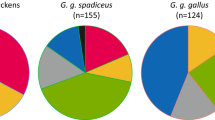Abstract
In order to elucidate the domestication history of Peking ducks, 190 blood samples from six Chinese indigenous duck breeds were collected with186 individualsgenotyped by 15 microsatellite markers. Both the FST and Nei’s standard genetic distances (Ds) from the microsatellite data indicated high genetic differentiation between Peking duck and other Chinese indigenous breeds. The haplotype network with mtDNA data showed that most of the Peking duck haplotypes were distinctly different from those of other domestic breeds. Although the H01 haplotype was shared by all domesticated duck breeds, Peking ducks displayed 12 specific domestic duck haplotypes, including four similar haplotypes H02, H04, H08 and H22, that formed a single haplogroup (A). Both H02 and H22 haplotypes were also shared by mallard and Peking ducks, indicating that Peking ducks originated from wild mallard ducks.
Similar content being viewed by others
References
Zhang Z G, Zhu X H. China animal science history collected works.; Beijing Science and Technology of China Press, 1986. 271–273
Chen M Y. Feeding and Breeding of Peking duck. Beijing: Science and Technology Publishing Press, 1986. 1–5
Zhang L. The role of Peking duck in duck production in the world. Chin J Anim Sci, 1989, 25: 56–57
Larson G, Dobney K, Albarella U, et al. Worldwide phylogeography of wild boar reveals multiple centers of pig domestication. Science, 2005, 307: 1618–1621, 10.1126/science.1106927, 1:CAS:528:DC%2BD2MXitV2is7k%3D, 15761152
Liu Y P, Wu G S, Yao Y G, et al. Multiple maternal origins of chickens: out of the Asian jungles. Mol Phylogenet Evol, 2006, 38: 12–19, 10.1016/j.ympev.2005.09.014, 1:CAS:528:DC%2BD2MXhtlSiu7vI, 16275023
Qu L J, Li X Y, Xu G F, et al. Evaluation of genetic diversity in Chinese indigenous chicken breeds using microsatellite markers. Sci China Ser C: Life Sci, 2006, 49: 332–341, 10.1007/s11427-006-2001-6, 1:CAS:528:DC%2BD28XhtVGitrzF
Liu W, Hou Z C, Qu L J, et al. Population structure and biodiversity of Chinese indigenous duck breeds revealed by 15 microsatellite markers. Asian Australas J Anim Sci, 2008, 21: 314–319, 1:CAS:528:DC%2BD1cXmtFSms70%3D
Maak S, Neumann K, Gatermann R. First seven microsatellites developed for the Peking duck (Anas platyrhynchos). Anim Genet, 2000, 31: 228–241, 10.1046/j.1365-2052.2000.031003228.x
Maak S, Wimmers K, Weigend S. Isolation and characterization of 18 microsatellites in the Peking duck (Anas planrhynchos) and their application in other waterfowl species. Mol Ecol Notes, 2003, 3: 224–227, 10.1046/j.1471-8286.2003.00405.x, 1:CAS:528:DC%2BD3sXlt12hsbY%3D
Li H, Yang N, Chen K, et al. Study on molecular genetic diversity of native duck breeds in China. World’s Poultry Sci J, 2006, 62: 603–607, 10.1017/S0043933906001152
Lai S J, Liu Y P, Liu Y X, et al. Genetic diversity and origin of Chinese cattle revealed by mtDNA D-loop sequence variation. Mol Phylogenet Evol, 2006, 38: 146–154, 10.1016/j.ympev.2005.06.013, 1:CAS:528:DC%2BD2MXhtlSiu7vK, 16054846
Lai S J, Chen S Y, Liu Y P, et al. Mitochondrial DNA sequence diversity and origin of Chinese domestic yak. Anim Genet, 2007, 38: 77–80, 10.1111/j.1365-2052.2007.01555.x, 17257194
Liu Y P, Wu G S, Yao Y G, et al. Multiple maternal origins of chickens: out of Asian jungles. Mol Phylogenet Evol, 2006, 38: 12–19, 10.1016/j.ympev.2005.09.014, 1:CAS:528:DC%2BD2MXhtlSiu7vI, 16275023
Sambrook J, Fritsch E F, Maniatis T. Molecular cloning: A laboratory Manual. 2nd ed. Beijing: Science Publishing Press, 1999. 43–370
Marshall T C, Slate J, Kruuk L E, et al. Statistical confidence for likelihood-based paternity inference in natural populations. Mol Ecol, 1998, 7: 639–655, 10.1046/j.1365-294x.1998.00374.x, 1:STN:280:DyaK1c3ps1Olsw%3D%3D, 9633105
Yeh F C, Yang R C, Boyle T, et al. POPGENE, the user-friendly software for population genetic analysis. Molecular Biology and Biotechnology Centre, University of Alberta, Canada. 1997
Rozas J, Sanchez-DelBarrio J C, Messeguer X, et al. DnaSP, DNA polymorphism analysis by the coalescent and other methods. Bioinformatics, 2003, 19: 2496–2497, 10.1093/bioinformatics/btg359, 1:CAS:528:DC%2BD3sXpvVSisLo%3D, 14668244
Nei M. Genetic distance between populations. Am Nat, 1972, 106: 283–293, 10.1086/282771
Nei M. Estimation of average heterozygosity and genetic distance from a small number of individuals. Genetics, 1978, 89: 583–590, 17248844
Brohede J, Møller A P, Ellegren H. Individual variation in microsatellite mutation rate in barn swallows. Mutat Rese, 2004, 545: 73–80, 1:CAS:528:DC%2BD3sXpvF2rtrc%3D
Bandelt H J, Forster P, Rohl A. Median-joining networks for inferring intraspecific phylogenies. Mol Biol Evolution, 1999, 16: 37–48, 1:CAS:528:DyaK1MXjvVGltA%3D%3D
Zhang Y. The origin and molecular diversity of China local buffalo. Beijing: China Agricultural University, 2006
Zhang T J, Li H F, Chen K W, et al. Analysis on the Genetic Polymorphism and Systematic Evolution in Domestic Ducks by Mitochondrial DNA D-loop Region. Acta Vet Zootechn Sin, 2007, 38: 1168–1175, 1:CAS:528:DC%2BD1MXjtlyjug%3D%3D
Bruford M W, Bradley D G, Luikart G. DNA markers reveal the complexity of livestock domestication. Nat Rev Genet, 2003, 4: 900–910, 10.1038/nrg1203, 1:CAS:528:DC%2BD3sXptFaht7o%3D, 14634637
Komiyama T, Ikeo K, Gojobori T. Where is the origin of the Japanese gamecocks? Gene, 2003, 317: 195–202, 10.1016/S0378-1119(03)00703-0, 1:CAS:528:DC%2BD3sXosFyis7s%3D, 14604808
Komiyama T, Ikeo K, Gojobori T. The evolutionary origin of long-crowing chicken: Its evolutionary relationship with fighting cocks disclosed by the mtDNA sequence analysis. Gene, 2004, 333: 91–99, 10.1016/j.gene.2004.02.035, 1:CAS:528:DC%2BD2cXksFOmtro%3D, 15177684
Author information
Authors and Affiliations
Corresponding authors
Additional information
Contributed equally to this work
Supported by the National Nature Science Foundation of China (Grant No. 30500357), and the National Key Basic Research Program of China (Grant No. 2006CB102102)
Rights and permissions
About this article
Cite this article
Qu, L., Liu, W., Yang, F. et al. Origin and domestication history of Peking ducks deltermined through microsatellite and mitochondrial marker analysis. SCI CHINA SER C 52, 1030–1035 (2009). https://doi.org/10.1007/s11427-009-0145-x
Received:
Accepted:
Published:
Issue Date:
DOI: https://doi.org/10.1007/s11427-009-0145-x




